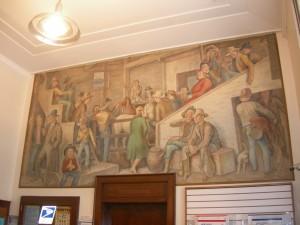Englewood Post Office
Full Article
The 1938 Englewood post office building on South Broadway is notable for its large lobby mural by Boardman Robinson (1876–1952), an important art educator, political cartoonist, and founder of the American mural movement. The work is Robinson’s only post office mural and one of three major Robinson murals to survive intact in their original location.
New Post Office
Englewood received its mail from the Denver post office until the 1930s. Talk of an independent Englewood post office started in 1929, then moved forward rapidly after 1935 because of lobbying efforts, Denver’s growth, and New Deal construction projects. Englewood was selected for a new post office in September 1936. At that time the city had a population of 8,600, with another 6,000 people in the surrounding area who would be served by the post office.
The Englewood post office was built on the east side of South Broadway, on a lot that was probably vacant. Ground was broken in November 1937 at a celebration featuring speeches and the Englewood High School marching band. The cornerstone was laid the following March, and the post office was dedicated on September 22, 1938.
The post office was the first federal building in Englewood and the only federal building constructed in the city as part of the New Deal. It cost about $94,000. At the time it was built, the one-story redbrick post office with Colonial Revival elements was one Englewood’s most architecturally sophisticated buildings.
Robinson’s Mural
Murals were popular in the 1930s as a democratic art form that could bring complex subjects to the public, and New Deal initiatives such as the Treasury Department’s Section of Fine Arts program were established in order to put artists to work painting murals in federal buildings across the country.
In April 1939 Postmaster James Adams asked about getting a mural for the lobby of the Englewood post office. His request for a mural was approved in May 1939. By June the Section of Fine Arts had commissioned Boardman Robinson, then living in Colorado Springs, to do the mural. Along with his friend Thomas Hart Benton, Robinson is regarded as a founder of the American mural movement of the 1920s and 1930s. After working for decades as a political cartoonist in New York, Robinson moved to Colorado Springs in 1930 to join the faculty of the newly founded Fountain Valley School. In the mid-1930s he became director of art school at the Colorado Springs Fine Arts Center, which he made into a center of the mural movement.
In July 1939 Robinson visited the Englewood post office. He submitted his preliminary sketch for the mural in September. It was not well received. The reviewer found Robinson’s subject for the mural inappropriate and “frivolous,” and wrote that it should be more serious and dignified.
Robinson responded with a second sketch in October. This sketch received a positive review, and Robinson got to work. He completed the mural, called Colorado Stock Sale in August 1940. It was displayed for a few weeks at the Colorado Springs Fine Arts Center, where Robinson served as art director, before being installed in the Englewood post office in October. The mural was one of sixteen placed in Colorado post offices between 1936 and 1942.
The six-foot-by-twelve-foot Colorado Stock Sale was Robinson’s last mural. Depicting a horse auction in rural Colorado, it is Robinson’s only major mural to reflect the evolution of his style toward a naturalistic regionalism after his move to Colorado.
Postwar Developments
The post office stood on the northern edge of Englewood when it was built. Soon commercial development followed the post office north along Broadway. Englewood pushed north toward Denver, which in turn grew south to meet it. After World War II, Englewood developed as a suburb within the larger Denver metropolis.
The Englewood post office survived without many changes. It continues to have the look and feel of a small-town New Deal post office. The building was originally in the middle of its block on South Broadway, but in the 1980s East Floyd Avenue was rerouted to alleviate traffic problems. As a result, the post office is now on a slightly larger corner lot, though the building has not moved.
In January 2010 the US Postal Service listed the Englewood post office for closure. Strong opposition from hundreds of customers, preservationists, art enthusiasts, and government officials resulted in a quick reversal of the decision and led to a successful effort later that year to get the building listed on the National Register of Historic Places.

















